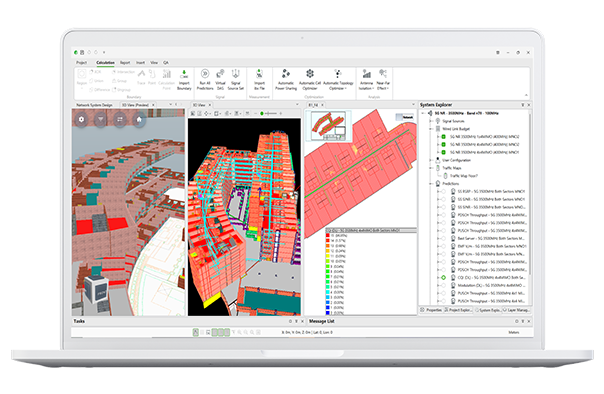Enhancing Connectivity Across Offshore Substation and Wind Farms

Enhancing industrial connectivity across the Offshore Substation and Wind Farm with optimized TETRA, Wi-Fi, VHF/AIS network designs
Overview
Hitachi Energy collaborated with Ranplan to conduct an in-depth signal propagation analysis for TETRA networks (operational safety communications), Wi-Fi 6 (data exchange), and VHF/AIS systems (maritime communications) at the Offshore Substation (OSS) and Baltyk II Wind Farm Poland. This initiative aimed to optimize network design and assess system performance in a complex industrial setting, involving a seven-story offshore structure and an expansive outdoor wind farm.
Ranplan Professional was used to model, simulate, and analyze signal propagation across these environments, leveraging its advanced 3D model imports, ray-tracing capabilities and tailored material definitions.
The Challenge
Designing a wireless network in industrial and offshore settings presented multiple challenges:
- Complex Structural Environment: The OSS comprises seven floors with intricate layouts and materials such as steel, which significantly affect signal propagation.
- Indoor and Outdoor Coverage Needs: Achieving seamless signal coverage within the dense structure of the OSS and across the vast outdoor wind farm posed unique requirements.
- Material and Environmental Interference: Signal degradation due to steel materials and environmental factors such as proximity to the sea.
- Regulatory and Safety Compliance: Ensuring compliance with electromagnetic field (EMF) safety limits and industry standards.
These challenges required a robust solution capable of addressing both the technical and regulatory complexities of the project.

Our Solution
Ranplan Professional was utilised to address these challenges through its comprehensive suite of tools:
3D Building Modelling:
Importing IFC files of the 3D OSS model created in BIM software significantly reduced modelling time from weeks to minutes. Ranplan’s tool automatically identified layers,
materials, and structural elements, streamlining the design process.
Material Definition:
Custom building materials were created in Ranplan’s database, including 1.5cm-thick steel walls and decks, to ensure precise simulation of signal propagation.
Advanced Signal Propagation Analysis:
Multi-ray tracing technology simulated TETRA signal coverage (indoor and outdoor), Wi-Fi 6 coverage (indoor), and VHF & AIS system performance (outdoor). Key performance indicators (KPIs) such as received signal strength (RSSI), uplink transmit levels, signal quality, and data rates were evaluated.
Indoor DAS for TETRA:
Designed a redundant dual-base station (BS) system with high-power base stations located in utility decks. Incorporated standard coaxial cables, indoor panel antennas, and omni-directional antennas into the DAS design, optimizing placement for maximum
efficiency. Addressed coverage for each OSS deck with specific antenna configurations and cabling.
Optimized Antenna Placement:
Ranplan analysed various antenna configurations, including rooftop installations for TETRA and VHF & AIS along with wall-mounted positions for Wi-Fi 6 access points (APs), to maximize indoor and outdoor coverage while minimizing interference and power consumption.
Data-Driven Insights:
Comprehensive heatmaps and performance reports provided actionable insights for precise system design and adjustments.
Regulatory Assurance:
Ranplan evaluated the EMF exposure levels to ensure they remained well within safety limits, supporting regulatory compliance.

Results
Ranplan Professional provided actionable insights, enabling data-driven decisions for efficient network deployment.
TETRA Network Coverage
- Outdoor Coverage: The wind farm’s outdoor region achieved over –70dBm coverage for 100% of the analysed area, with antennas positioned 50m+ above sea level.
- Indoor Coverage: Signal analysis of both antennas showed challenges due to steel interference, requiring an indoor DAS solution to achieve coverage of –80dBm across all decks.
Wi-Fi 6 Network Performance
- Indoor Coverage: Ten strategically placed APs achieved an RSSI above –70dBm across 98% of the target areas.
- Data Rates: Steel walls minimized signal leakage, allowing robust
throughput and optimal download speeds.
VHF & AIS System Performance
- VHF System: Achieved coverage of –60dBm or better across nearly 100% of the wind farm region, 5m above sea level (cruiser deck level).
- AIS System: Achieved similar outdoor coverage levels, ensuring reliable maritime communication.
Efficiency:
Automated workflows reduced design time & by 30%, accelerating project completion.
Cost Savings:
Power optimization reduced base station transmit power by 10–20dB, lowering operational costs.
Reliability:
A redundant dual-base station TETRA system design provided robust network reliability
Compliance
EMF analysis confirmed safe electric field strength below 0.4 V/m, well under the 28.5 V/m limit. Antenna and AP placements adhered to safety guidelines, maintaining a 2m
minimum distance from personnel.
“Ranplan’s advanced tools and expertise were instrumental in achieving optimal network design despite the complexities of the OSS and wind park environments. The ability to re-use 3D models and visualize the signal propagation in such detail has been a game changer for our projects.”
— Giovanni Distefano, Senior Systems Engineer,
Hitachi Energy Switzerland
Unlock the full potential of 5G with Ranplan’s cutting-edge network planning tools



